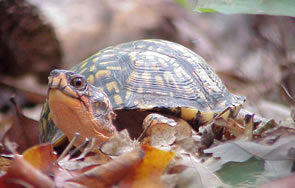
Eastern Box Turtle
Terrapene carolina
Description: Eastern box turtles are small to medium sized turtles, attaining a maximum length of 8 inches (20 cm) and possessing a highly domed carapace (top of shell). They have a hinged plastron (bottom of shell). While mud and musk turtles also possess hinged plastrons, box turtles are the only species which can shut their plastron completely. Coloration and amount of pattern are variable, but the carapace is usually brown with a orange or yellow pattern. Females can be distinguished from males based off several characteristics. Males usually possess red eyes, while the eyes of a female are usually brown. Females possess a more highly domed carapace. Finally, the plastron of male box turtles is concave while the female’s is not.
Feeding/Diet: Eastern box turtles are omnivores. They will eat almost anything that they can fit in their mouths including worms, insects, fruit and berries, mushrooms, and carrion – among other food items. As they mature their diet shifts from primarily animals towards one that includes more plant material.
Activity/Behavior: The eastern box turtle is the only fully terrestrial turtle encountered in North Carolina. They are active during the day (diurnal), particularly after rains. If it feels threatened, eastern box turtle can close itself completely within its shell.
Habitat/Range: Box turtles live in a wide variety of habitats from forested areas to dry grassy meadows to swamps and sandhills. Although they can live in a variety of habitats, they prefer moist forested areas with large amounts of underbrush. They do not travel far, usually living within an area less than 200 meters in diameter.
Reproduction: Eastern box turtles mature slowly, reaching sexual maturity between 7 and 10 years of age. Once mature, a female box turtle will lay between 3 and 6 eggs each spring in a shallow nest which hatch in late summer or early fall. Hatchling box turtles measure only 1.25 inches (3 cm) in length.
Miscellaneous: Eastern box turtles are declining over much of their range. They are very susceptible to habitat fragmentation, and road-related mortality. They also suffer from collection as pets. Because they take so long to mature, it is hard for box turtle populations to recover from these pressures. Box turtles also possess a homing instinct. If you find a box turtle on the road, do not take it home with you and release it. A box turtle released away from its home range will often wander until it dies. Rather – if it is safe – move the box turtle to the side of the road.
Click here to learn about box turtle research at Davidson College and how you can help!!
Click here to learn even more about eastern box turtles!!
Have you found an injured turtle in the North Mecklenburg Area? Carolina Veterinary Specialists may be able to help. Contact them at (704)949-1100, http://www.carolinavet.com/

The shaded region represents the range of the eastern box turtle in North Carolina.






Photo by J. Willson
Photo by J. Willson